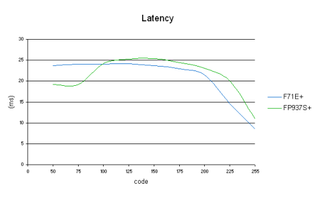8ms 19" LCDs: Speed for Gaming, but at What Cost?
Surprisingly Good Response
Since BenQ owns part of the capital of AU-Optronics, we hoped to find a new panel from that maker in this monitor. Unfortunately, that's not the case. But the FP937S+ uses a Samsung 190EX-L01, the same panel used in the Hyundai L90D+. And so obviously the results are excellent, and we're not about to complain!

Here again, depending on the adjustments, it's possible to attain 8ms. Let's say that going downhill with a tailwind, you can reach 8ms. But we chose a less extreme adjustment, and got a latency measurement of 10.5ms. As the curve shows clearly, this panel's responsiveness is excellent. The monitor is very reactive and can stand up to its 17", 8ms little brother, the BenQ FP71E+. BenQ really seems to be concentrating on the market for gamers' monitors by offering equipment that meets their needs exactly. The FP937S+ is a good gaming screen, there's no doubt about it.
If you're wondering why the curves for the FP937S+ and the L90D+ don't coincide exactly, you have to realize that LCD panels are built using a process similar to that used for electronic circuits. Consequently, a certain amount of dispersion during the fabrication process has to be taken into account. The choice of adjustments and the onboard electronics that manage contrast and brightness also enter into the picture. So in the final analysis, the curves are very close, but not identical.
In Practice
Using this monitor for office work can't be ruled out, but surely that's not really why you're interested in it. The panel isn't adjustable for height, but its default height is fairly well chosen. The excessive brightness might cause problems for some. Of course, as with the L90D+, you can lower the brightness, but you'll lose a little color fidelity.
Gaming is obviously the FP937S+'s real forte. Like the L90D+, it's a real treat for the eyes. The images are fluid, you don't lose a single grain of texture during scrolling, and tracks are almost invisible. Samsung has really done an admirable job on the 190EX-L01 panel. Unfortunately, the pixel interpolation is about at the same level as on the Hyundai. You'll have to play in native resolution or it'll spoil your fun a little.
As with the Hyundai, again, video is not a strong point here. Images were quite noisy due to sparkling on color masses. And the viewing angles are extremely poor. You really have to be directly in front of the monitor to see a good image. Any viewers who are even slightly to one side will be at a disadvantage.
Stay on the Cutting Edge
Join the experts who read Tom's Hardware for the inside track on enthusiast PC tech news — and have for over 25 years. We'll send breaking news and in-depth reviews of CPUs, GPUs, AI, maker hardware and more straight to your inbox.
Finally, the FP937S+ is fit to stand beside the FP71E+, with its exemplary responsiveness. Gamers can choose it without hesitation. Obviously, a shell with better build quality would have been nice on a monitor of this class, but we'll have to do without it in the hope that BenQ will rethink the design of its next models.
Current page: Surprisingly Good Response
Prev Page Good Color Fidelity Next Page Samsung SyncMaster 913N: Samsung According To SamsungMost Popular

